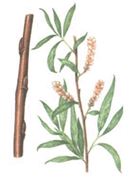
Willow Bark
Introduction
This fact sheet provides basic information about Willow Bark. The genus Salix has nearly 450 species. Most willows are found in temperate and arctic zones, but some species can be located in subtropical and tropical zones. They are geographically distributed in all continents except Antarctica and Australia. Willows include small trees, shrubs, and groundcovers, and many species are dioecious with male and female catkins (flowers) on separate plants.The medicinal use of willow dates back 6,000 years. Ancient civilizations used willow tree extracts to treat pain, inflammation, and musculoskeletal conditions. Assyrian clay tablets excavated by archaeologists document these uses of willow and also in treating fever. Egyptians used willow to treat joint pain and inflammatory conditions associated with wounds. Chinese civilizations used willow to treat fever, pain, colds, hemorrhages, goiter, and rheumatic fever and applied willow as an antiseptic for wounds and abscesses. Physicians of ancient Greece, including Dioscorides who wrote the precursor to all modern pharmacopeias, prescribed willow for its analgesic and anti-inflammatory properties.
North American willows have also been used in folk medicine. Most of the European medicinal willows were introduced to the Americas and escaped cultivation. In the late 19th century, salicylic acid was widely used in place of willow bark, and its derivative, aspirin, was discovered to be less irritating to the mouth and stomach.
Common Names
Willow Bark, Willow, Weidenrinde, White Willow, Purple Qsier Willow/Basket Willow, Crack WillowLatin Names
Salix albaWhat It Is Used For
- Willow bark can be an effective analgesic if the salicylate content is adequate. Anticancer, antioxidant, and anti-inflammatory activity has been documented in limited trials. Clinical trials have shown that willow has moderate efficacy in treating lower back pain but very little efficacy in treating arthritic conditions.
How It Is Used
Willow tea can be prepared by adding 1/4-1/2 teaspoon (1-2 grams) of bark to about 7 ounces (200 ml) of water and then boiling for ten minutes. This tea can be taken up to five times per day.What the Science Says
- Reports from clinical trials primarily document GI discomfort, such as nausea and stomachache, as well as dizziness and rash. An anaphylactic reaction to willow bark has been reported.
Side Effects and Cautions
- Patients with known hypersensitivity to aspirin should avoid any willow-containing product. This caution also applies to patients with asthma, impaired thrombocyte function, vitamin K antagonistic treatment, diabetes, gout, kidney or liver conditions, peptic ulcer disease, and in any other medical conditions in which aspirin is contraindicated.
Sources
- Drugs.Com Web site. Accessed on February 7, 2009.
- From Wikipedia, the free encyclopedia. Accessed on February 7, 2009.






